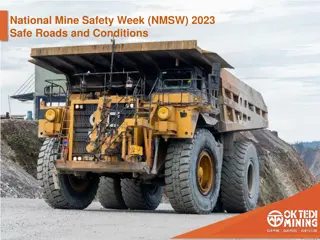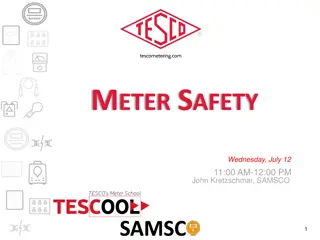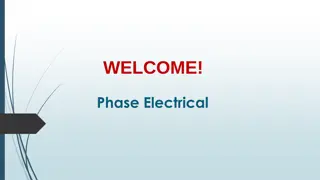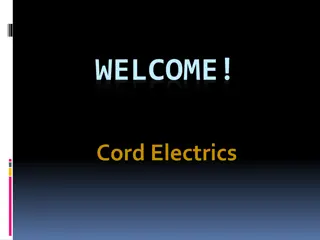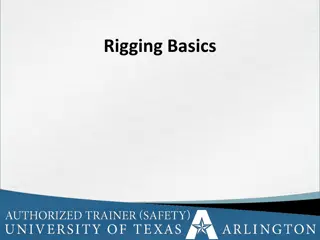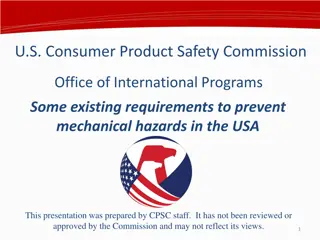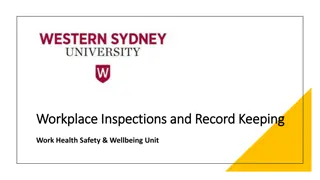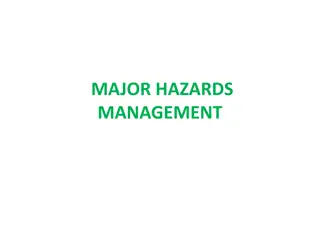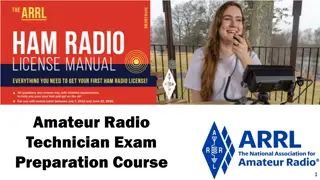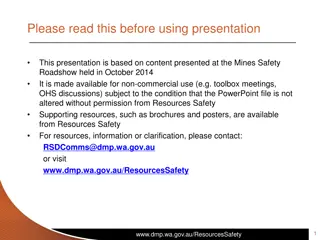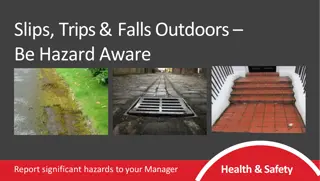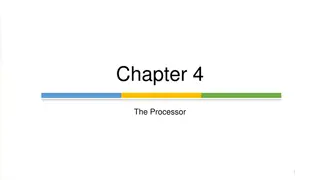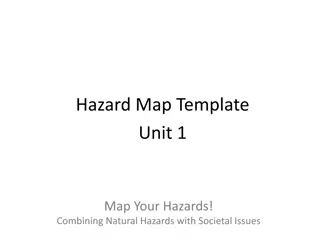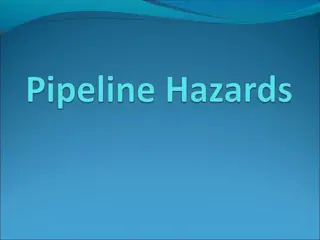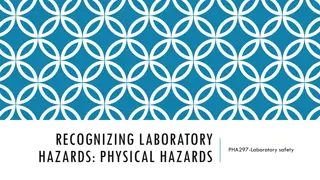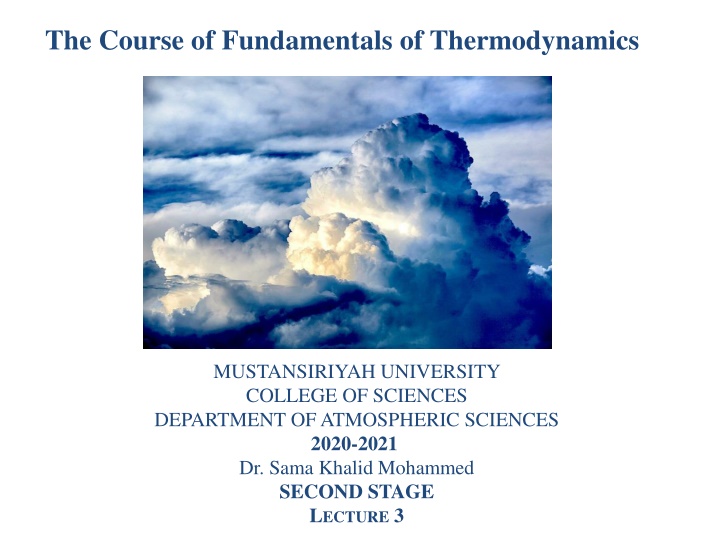
Electrical Safety Tips to Prevent Hazards
Reduce the risk of electrical accidents by following essential safety tips like keeping hands dry, avoiding overloaded outlets, and using proper extension cord practices. Learn about electrical hazards, awareness statistics, and ways to minimize risks to stay safe around electricity.
Download Presentation

Please find below an Image/Link to download the presentation.
The content on the website is provided AS IS for your information and personal use only. It may not be sold, licensed, or shared on other websites without obtaining consent from the author. If you encounter any issues during the download, it is possible that the publisher has removed the file from their server.
You are allowed to download the files provided on this website for personal or commercial use, subject to the condition that they are used lawfully. All files are the property of their respective owners.
The content on the website is provided AS IS for your information and personal use only. It may not be sold, licensed, or shared on other websites without obtaining consent from the author.
E N D
Presentation Transcript
The Course of Fundamentals of Thermodynamics MUSTANSIRIYAH UNIVERSITY COLLEGE OF SCIENCES DEPARTMENT OF ATMOSPHERIC SCIENCES 2020-2021 Dr. Sama Khalid Mohammed SECOND STAGE LECTURE 3
Welcome Students In The Welcome Students In The New Course New Course And In And In The The Third Lecture Third Lecture
This lecture including the following items Thermodynamic variables ( continue ) Heat and Work The laws of thermodynamics The first law of thermodynamics p-v work.
Pressure In fluids (gases and liquids) at rest, the pressure at a given point is the same in all directions. Pressure of a fluid at rest increases with depth (due to added weight), but constant in horizontal planes.
Pressure The actual pressure at a given position is called the absolute pressure, and it is measured relative to absolute vacuum. i.e. absolute zero pressure. Pressure Gauges are generally designed to indicate ZERO at local atmospheric pressure, the difference is known as Gauge Pressure. P (gauge) = P (abs) P (atm) Pressure less than local atmospheric pressure is known as Vacuum Pressure. P (vacuum) = P (atm) P (abs) In thermodynamics calculations, always use absolute pressure. Most pressure measuring devices are calibrated to read zero in the atmosphere (they measure Pgauge or Pvac).
Temperature Scales Experimentally obtained Temperature Scales: the Celsius and Fahrenheit scales, are based on the melting and boiling points of water. They are also called two point scales. Conventional thermometry depends on material properties e.g. mercury expands with temperature in a repeatable and predictable way Thermodynamic Temperature Scales (independent of the material), the Kelvin and Rankine scales, are determined using a constant volume gas thermometer.
Heat and Work Energy can cross the Boundary of the System or from one system to another in 2 forms : 1. Heat , 2. Work Heat and work are modes of transfer of energy and not energy itself Heat is the transfer of thermal energy while work is the transfer of mechanical energy Energy Transfer in from of Heat by 3 ways : ( conduction, convection and radiation ) CONDUCTION: Transfer of Energy from a more energetic particle of a substance to the adjacent less energetic one, as a result of interaction between them. CONVECTION: Transfer of Energy between a solid surface and the adjacent fluid that is in motion. It involved both, the combined effect of conduction and fluid motion. RADIATION: Transfer of Energy due to the emission of electromagnetic waves.
Work & Heat Heat is NOT a form of energy; it is a mode of transfer of energy . The transfer is done due to temperature difference Bodies contain internal energy and notheat (nor work!). Heat involves random motion of matter Like gas molecules in a gas cylinder Water molecules in a cup of water Atoms vibrating in a block of Cu.
Work & Heat Work (W) in mechanics is displacement (d) against a resisting force (F). ( or the Energy transfer associated with a Force acting through a distance ) W = F d (in units of Joule, J (units of energy)) Work can be expansion work (P V), electrical work, magnetic work etc. Maximum work will be done if the compression (or expansion) is carried out in a reversible manner. Work is coordinated flow of matter. Lowering of a weight can do work Motion of piston can do work Flow of electrons in conductor can do work.
Similarities between HEAT & WORK : Both are recognized at the Boundary of the System, as they cross the Boundary. Hence both are Boundary Phenomena. System possesses Energy, but neither Heat nor Work. Both are associated with Process, not State. Heat and Work have NO meaning at a State. Both are Path Functions. The Path Function is the Magnitude depends on the Path followed during the Process, as well as the End States, and have Inexact Differentials denoted by ). While Point Function is the Magnitude depends on State only, and not on how the System approaches that State, and have exact Differentials denoted by d).
Heat and work each have their own distinct properties, and they differ in how they affect a system. These are listed and compared below Work (W) Heat (Q) Interaction Requires Mechanical Force and Displacement Macroscopic pushes and pulls Thermal Temperature difference Process Microscopic collisions Q > 0 when the environment is at a higher temperature than the system. Energy is transferred into system. Q < 0 when the system is at a higher temperature than the environment. Energy is transferred out of system. A system is in thermal equilibrium when it is at the same temperature as the environment. W > 0 when a gas is compressed. Energy is transferred into system. Positive value W < 0 when a gas expands. Energy is transferred out of system. Negative value A system is in mechanical equilibrium when there is no net force or torque on it. Equilibrium
THE LAWS OF THERMODYNAMICS The four laws of thermodynamics are essentially postulates that are assumed to be true, and have never (so far) been seen to fail. ZEROTH LAW The Zeroth Law of Thermodynamics states that if two systems are each separately in equilibrium with a third system, then the first two systems are also in equilibrium with each other
THE LAWS OF THERMODYNAMICS FIRST LAW The First law of Thermodynamics can be summarized in a statement that energy is conserved, and it will be explained in details later on. SECOND LAW The Second Law of Thermodynamics has several possible equivalent statements, two of them are: The entropy of an isolated system can never decrease. It is impossible for an engine operating in a cyclic process to convert energy into work with 100% efficiency.
THE LAWS OF THERMODYNAMICS THIRD LAW There are several different statements of the Third Law, among them are: The entropy change of a substance goes to zero as temperature approaches absolute zero. The entropy of a pure substance is zero at absolute zero. A consequence or result of the First, Second, and Third Laws is that: It is impossible to reduce the temperature of a substance to absolute zero (0 K) in a finite number of steps, in other words, it would take an infinite number of steps to reach absolute zero, so therefore, it is unattainable.
THE FIRST LAW OF THERMODYNAMICS The first law of thermodynamics expresses the conservation of energy. It is given as: dU = dQ + dW The first law states that the internal energy of a system can be changed either through heating or through work. Using intensive properties, the first law becomes du = dq + dw. Our convention will be that heat added to the system and work done on the system will be positive. Thus, work done by the system on its surroundings will be negative.
P-V WORK Work is defined as force acting over a distance, If a gas expands quasi-statically against a pressure, p, the work done by the gas is given by the pressure multiplied by the change in volume, V, or Equation (1) is only valid if the process is quasi-static with respect to mechanical equilibrium. The system does not have to be near thermal equilibrium in order to use Eqn. (1), as long as it is close to being in mechanical equilibrium. The negative sign is included because work is being done by the system. The first law is then written
In terms of specific quantities, the first law is The first law in this form tells us that if a gas expands then its internal energy must either decrease, or heat must be added to it in order to keep the internal energy from decreasing. In an adiabatic process, no heat is added or subtracted. Therefore dq = 0. This means that if a gas expands adiabatically its internal energy (and hence, its temperature) will decrease.
Reversible P-V work on a closed system In a closed system (piston for example figure below), if infinitesimal pressure increase causes the volume to decrease by V, then the work done on the system is: The system is close to equilibrium during the whole process thus making the process reversible. work done on the system is positive, work done by the system is negative As V is negative, the work done is positive. If the piston moves outward under influence of P (i.e. P and V are in opposite directions, then work done is negative. = reversible dw PdV 1 Note that the P is the pressure inside the container. For the work to be done reversibly the pressure outside has to be P+ P (~P for now). Since the piston is moving in a direction opposite to the action of P, the work done by the surrounding is P V (or the work done by the system is P V, i.e. negative work is done by the system). P (P+ P) 2



